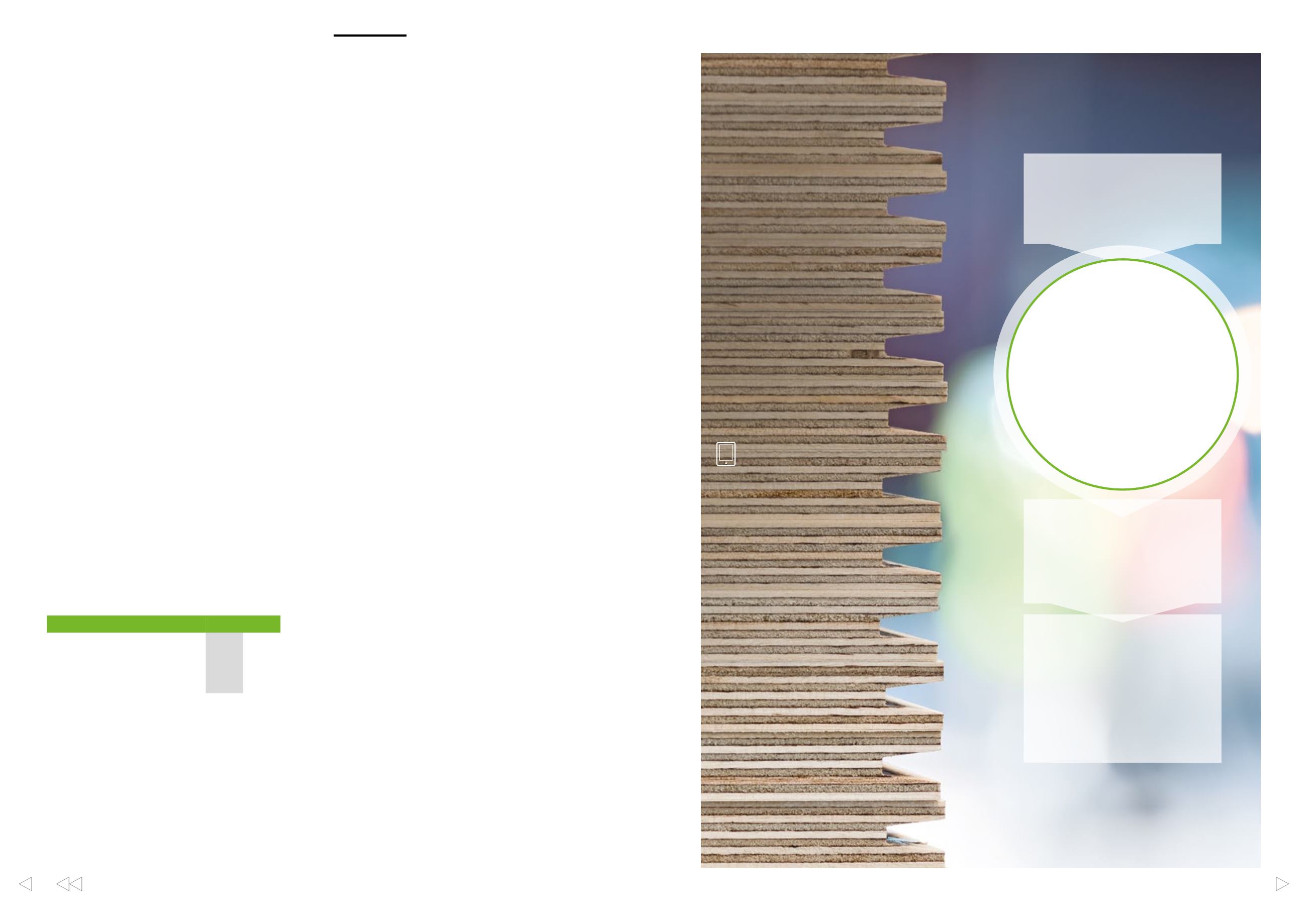

UPM Annual Report 2016
UPM Annual Report 2016
36
37
In brief
Strategy
Stakeholders
Governance
Accounts
Businesses
INVESTMENT TO EFFICIENCY
Investment in the Otepää mill is improving
production processes and material efficiency
in many ways.
The new, highly automated and well-
protected production lines improve work
efficiency and ergonomics as well as reduce
the risk of work-related injuries and illnesses.
Production capacity has increased by
approximately 90%.
The old boiler that was partially reliant on
oil burning has been replaced with a new
biomass boiler. The new boiler uses
plywood production by-products such as
bark, chips and dust as fuel, thus improving
material efficiency. Switching from oil to
renewable energy reduces fossil CO
2
emissions by 85% and lowers energy costs.
As a result of the expansion, the team at
the mill grew by one third as approximately
40 new employees were hired. The project
has also provided work for several local
companies over the past year and a half.
Out of over 100 suppliers involved in the
project, approximately 80% of contracts
have been concluded with local companies.
Read more:
www.wisaplywood.com, www.upmbiofore.comCONTENTS
UPM Plywood
OUR DIRECTION
•
Profitable growth through superior customer
experience and operational excellence
•
Strengthen market position in selected businesses
by increasing value and service offering
OUR STRENGTHS
•
Customer insight and superior customer service
•
Reliable supplier with consistent high quality
•
Leading supplier in demanding end-use segments
•
Strongest brand in the market — WISA
®
GROWTH DRIVERS
•
Building and construction activity in Europe
•
Road transportation in Europe
•
LNG carrier and terminal investments globally
•
Growing e-commerce
Growth to
meet customer
demand
Top performance continued
Profitability increased due to lower costs, partly supported by favourable
currency impact, and higher delivery volumes. The Finnish birch mill
competitiveness improvement programme proceeded, enabling increased
production and lower unit costs.
UPMPlywood completed the expansion of the UPMOtepää mill in
Estonia in the fourth quarter. The expansion increases the mill’s production
capacity to 90,000 cubic metres per year. The new biomass boiler enhances
the mill’s material efficiency and reduces fossil carbon dioxide emissions by
85%. The investment enhances value as it responds to growing demand for
high-quality birch plywood products in key customer markets.
The market environment improved gradually during the first half of 2016
in Europe, and demand is estimated to have increased since the previous
year. The impact of low-priced imports in the beginning of the year eased in
the second quarter. Demand picked up, particularly in birch plywood-related
industrial applications, but also to some extent in construction-related
end-use segments. Deliveries to demanding industrial end-use applications
increased: vehicle floors to trailer manufacturers and insulation material for
LNG carriers. Activity in the building and construction industry improved
with good results. Market prices decreased at the beginning of the year,
but increased slightly during the second half of the year.
Building and construction
In building and construction, UPMPlywood is the leading supplier in the
high-end segments in Europe thanks to an established distribution network.
After years of low construction activity in Europe a gradual recovery
continued in 2016. UPMPlywood seeks further growth by strengthening
distribution in selected emerging markets.
Vehicle flooring
In transportation equipment, UPMPlywood provides expertise for
customers’ product and production development, introducing both
economic and environmental benefits. Demand growth for trailers is driven
by economic activity and a replacement need created after the financial crisis
in 2008. Growing e-commerce volumes drives growth in light vehicles by
transferring the delivery flows from terminals directly to consumers and
thus increasing parcel deliveries. UPMPlywood seeks growth by expanding
to newmarkets and end-use segments.
LNG carriers
UPMPlywood has seen solid growth in the LNG (liquefied natural gas)
segment in past years. WISA birch plywood is ideal material in LNG
vessels due to its strength and stability at extremely low temperatures.
UPMPlywood provides on-time deliveries of certified quality through long-
term contracts. UPMPlywood secures its leading position and seeks growth
through extending its offering into related applications with same
technology.
Plywood from sustainably managed forests
Forest certificates guarantee that the wood rawmaterial is from sustainably
managed forests with legal logging operations. All wood rawmaterial is used
either in plywood production, as rawmaterial to other products or in energy
generation. Plywood is increasingly used because it is a cost-effective
material, a renewable resource and carbon storing product.
Integrated plywood and renewable energy production enhances material
efficiency and reduces fossil fuel emissions at mill sites. Biomass boilers
produce most mills’ thermal energy using the production by-products as fuel.
In addition, plywood manufacturing consumes less energy compared to e.g.
aluminium, plastic or steel.
CAPITALS
•
Moderately labour and
capital intensive industry
•
Engaged high performing people
•
Community engagement
•
Wood from certified sources with
full traceability
UPM PLYWOOD
VALUE CREATED
Thorough customer insight
Professional technical services, supply chain services
High quality, reliable supplier
Leading supplier in demanding end uses
Strong brand
Renewable energy production
•
Construction
•
Vehicle flooring
•
LNG shipbuilding
•
Parquet
•
Other industrial
manufacturing
END USES
•
Employment
•
Vitality of local communities
•
Work safety
•
Safe and certified products
•
Carbon storing products
•
Renewable energy
•
Low emissions
•
ROCE
•
Growth
SOCIAL
IMPACT
ENVIRONMENTAL
IMPACT
OUTCOMES
ECONOMIC
IMPACT
KEY FIGURES
2016 2015
Sales, EURm
444
439
Comparable EBIT, EURm
58
55
Capital employed (average), EURm
259
263
Comparable ROCE, %
22.6
20.9
Personnel on 31 Dec.
2,469
2,469


















